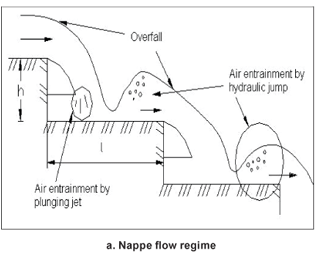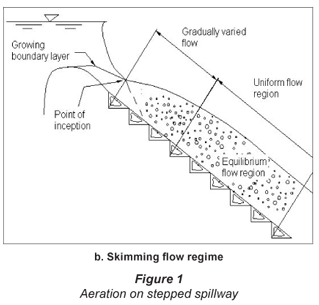Servicios Personalizados
Articulo
Indicadores
Links relacionados
-
 Citado por Google
Citado por Google -
 Similares en Google
Similares en Google
Compartir
Water SA
versión On-line ISSN 1816-7950
versión impresa ISSN 0378-4738
Water SA vol.36 no.3 Pretoria abr. 2010
Comparison of stepped and smooth spillway effects on stream reaeration
Egemen ArasI,*; Mehmet BerkunII
IGumushane University, Department of Civil Engineering, Gumushane 29100, Turkey
IIKaradeniz Technical University, Department of Civil Engineering, Trabzon 61080, Turkey
ABSTRACT
The oxygen transfer at a hydraulic structure happens by self-aeration through the spillway and by flow aeration in the hydraulic jump downstream of the hydraulic structure. Spillways with their water-air controlling mechanisms are important not only for their structural properties but also for their effects on stream ecology. Spillway types also affect the efficiency of aeration. Decisions on the types of spillway should be made by taking the environmental conditions and flow rates into consideration.
This paper compares the aeration efficiency of stepped and smooth spillways. Empirical correlations predicting length of the non-aerated flow region and aeration efficiency are developed. Smooth and stepped spillways cause increased dissolved oxygen (DO) concentrations at the downstream part of the channel. DO concentration changes are shown to depend on the flow types, discharge rates, tail-water depth and travelling times.
Keywords: dissolved oxygen, spillway, stream, re-aeration, aeration efficiency
Introduction
Air entrainment on spillways and chutes has recently been recognised for its contribution to the air-water transfer of atmospheric gases such as oxygen and nitrogen. This process must be taken into account for the re-oxygenation of polluted streams and rivers, but also to explain the high fish mortality downstream of large hydraulic structures. In rivers, artificial stepped cascades and weirs are introduced to enhance the dissolved oxygen (DO) content of polluted or eutrophic streams (Frizell, 1992; Toombes and Chanson, 2000). With large dams, the downstream nitrogen content is another important parameter since nitrogen super-saturation may increase the mortality of some fish species (Orlins and Gulliver, 1997). On stepped spillways, both the aeration of the flow and the strong turbulent mixing enhance the air-water transfer of chemicals (Brattberg and Chanson, 1998; Baylar et al., 2007). The strong turbulent mixing increases the coefficient of transfer in comparison with a quiescent fluid, and the large amount of entrained air bubbles increase the air-water interface area due to the cumulative bubble surface areas (Chen at al., 2000; Pfister et al., 2006). A DO deficit upstream of a structure of greater than 2.5 mg/ℓ is normally required for accuracy in oxygen transfer efficiency measurement. The primary source of measurement uncertainty is found to be in the oxygen saturation concentration. In the summer time, when the average saturation concentration is about 7 mg/ℓ in most areas, this specification results in an upstream DO of less than 4.5 mg/ℓ (Baylar et al., 2006; Carosi and Chanson, 2008).
The objective of this study was to investigate the effects of aeration caused by smooth and stepped spillways, in a laboratory model channel, and in relation to flow type, discharge rate, tail-water depth and channel slope.
Air entrainment on stepped spillways
The flow conditions on a stepped channel are characterised by a high level of turbulence. Air entrainment is caused by turbulence velocities acting next to the air-water free surface. Through this interface, air is continuously trapped and released. Air entrainment occurs when the turbulent kinetic energy is large enough to overcome both surface tension and gravity effects. The turbulent velocity normal to the free surface V' must overcome the surface tension pressure, and is greater than the bubble rise velocity component for the bubbles to be carried away. These conditions are:

where:
σ is the surface tension
ρw is the water density
dab is the air bubble diameter
Uris the bubble rise velocity
α is the channel slope
Air entrainment occurs when the turbulent velocity V' satisfies both Eqs. (1) and (2) (Chanson, 1994).
Aeration on steps
With a stepped cascade, low overflows result in a succession of free-falling nappes. The flowing waters bounce from one step to the next one as a series of small free falls. This flow situation is defined as a nappe flow regime. Stepped channels with nappe flows may be analysed as a succession of drop structures. For large discharges, the waters flow down a stepped channel as a coherent stream, skimming over the steps. In the skimming flow regime, the external edges of the steps form a pseudo-bottom over which the water skims. Beneath the pseudo-bottom, recirculating vortices develop, filling the zone between the main flow and the steps. The vortices are maintained through the transmission of shear stress from the fluid flowing past the edges of the steps.
Considering a stepped chute with nappe flow regime, air is entrained at each step by a plunging jet mechanism at the intersection of the over falling jet and the receiving waters, and at the toe of the hydraulic jump (Fig. 1a). With deep-pooled steps, most of the air is entrained by the plunging jet mechanism. For flat steps with shallow waters, most of the air is entrained at the toe of the hydraulic jump. The air entrainment characteristics of hydraulic jumps have been analysed by a number of researchers (Sene, 1988; Chanson, 1995; Kokpinar, 1996; Emiroglu and Baylar, 2005)
On a stepped spillway with skimming flow, the entraining region follows a region where the flow over the spillway is smooth and glassy. Next to the boundary, however, turbulence is generated and the boundary layer grows until the outer edge of the boundary layer reaches the surface. When the outer edge of the boundary layer reaches the free surface, the turbulence can initiate natural free surface aeration. The location of the start of air entrainment is called the point of inception. Downstream of the inception point of free-surface aeration, the flow becomes rapidly aerated and the free surface appears white. Far downstream the flow will become uniform and for a given discharge any measure of flow depth, air concentration and velocity distribution will not vary along the chute. This region is defined as the uniform equilibrium flow region (Fig. 1b).
Effects of aeration
In supercritical flows above chutes and spillways, the amount of entrained air is an important design parameter. Self-aeration is initially effective because of the effects of the entrained air volume of the flow. Air entrainment increases the bulk of the flow which is a determining parameter of the height of spillway sidewalls.
The presence of air within the boundary layer also reduces the shear stress between the flow layers and hence the shear force. The resulting increase of flow momentum must be taken into account when designing a ski jump and stilling basin downstream of a spillway, a stepped spillway or a rock-fill dam with possible overtopping (Gonzalez, 2005).
Further presence of air within high-velocity flows may prevent or reduce the damage caused by cavitation erosion which may occur on stepped spillways. But the risks of cavitation damage are reduced by the flow aeration. Peterka (1953) and Russell and Sheehan (1974) showed that 4% to 8% of air concentration next to the spillway bottom may prevent cavitation damage on concrete surfaces. On stepped spillways, the high rate of energy dissipation reduces the flow momentum in comparison with a smooth chute. The reduction of flow velocity and the resulting increase of flow depth also reduce the risks of cavitation as the cavitation index increases (Chanson, 1994; Peyras et al., 1992).
The flow bulking is estimated from the total quantity of air entrained while the prevention of cavitation damage requires the knowledge of the air concentration in the layers close to the spillway bottom. Reduction of drag observed with the air entrainment will reduce the energy dissipation above the spillway and hence its efficiency. It must be emphasised that the reduction of the friction factor observed with increasing mean air concentration is not completely understood. The presence of bubbles across the flow and the bubble size distribution is expected to affect the turbulence and the turbulent mixing mechanisms (Chanson, 1997).
Stream reaeration
One of the most important water quality parameters in rivers and streams is the DO content. The oxygen concentration is a prime indicator of the quality of the water. Dams and weirs across a stream affect the air-water gas transfer dynamics. Deep and slow pools of water upstream of a dam reduce the gas transfer process and the natural re-aeration as compared to an open river. But some hydraulic structures (e.g. spillway, stilling basin) can enhance the oxygen transfer during water releases (Aras and Berkun, 2008)
Organic waste from municipal, agricultural and industrial sources may overload the natural system, causing a serious depletion of the oxygen supply in the water. Water rich in nutrients produces algae in quantities which upon decomposition deplete the oxygen supply. Fish kills are often associated with this process of eutrophication. Habitats for warm-water fish populations should contain DO concentrations of not less than 4.0 mg/ℓ; habitats for cold-water fish populations should not be less than 5.0 mg/ℓ (Berkun and Onal, 2004).
On stepped spillways, both the aeration of the flow and the strong turbulent mixing enhance the air-water transfer of chemicals. The chemicals can be atmospheric gases or polluted matters. The strong turbulent mixing increases the coefficient of transfer in comparison with a quiescent fluid, and the large amount of entrained air bubbles increases the air-water interface area due to the cumulative bubble surface areas. Overall gas transfer at cascades and overflow weirs can be measured by the deficit ratio (r) defined as:

where:
E is the aeration efficiency
CUS is the upstream dissolved gas concentration
CDS is the dissolved gas concentra- tion at the downstream end of the channel
CS is the saturation concentration
r is deficit ratio
An upstream DO deficit of greater than 2.5 mg/ℓ is normally required for accuracy in oxygen transfer efficiency measurement. The primary source of measurement uncertainty was found to be the uncertainty in the oxygen saturation concentration. In the summer time, when the average saturation concentration is about 7 mg/ℓ in most areas, this specification results in an upstream DO of less than 4.5 mg/ℓ.
For comparability of measurement results, aeration efficiency is usually standard under a particular temperature. This reference temperature shall be taken as 20ºC:

where
E20 is the aeration efficiency at 20ºC
T is the temperature
fTis the coefficient-related temperature
Materials and methods
A stepped spillway with a height of 13.5 cm, length of 12 cm and width of 10 cm with 4 steps was used for the experiment. A smooth spillway with a height of 10 cm, length of 15 cm and width of 10 cm was also tested. Three meters ofchannel length was provided downstream of the crest. Both the approach channel and the tail channel had the same width (10 cm) as the spillway (Fig. 2). Water flowed from the main tank to the channel. There was no special reason for the choice of this channel width. Dimensions were kept constant to make an accurate comparison.
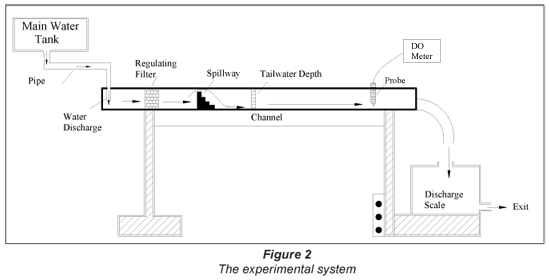
In the upstream portion of the spillway, DO concentration during testing was 6.5 mg/ℓ and water temperature was 10ºC. Saturation concentration was 11.3 mg/ℓ at 10ºC. It was not necessary to add any chemicals to the water because the difference was greater than 2.5 mg/ℓ.
Dissolved oxygen concentration was measured upstream of the spillway (A) and at 4 different points (B, C, D, E) downstream of the spillway (Fig. 3). The discharge of the spillway was 0.10, 0.15, 0.20, 0.32, 0.40 ℓ/s, respectively. Dissolved oxygen concentration was measured by a DO meter (Hach HQ10) (Aras, 2009).
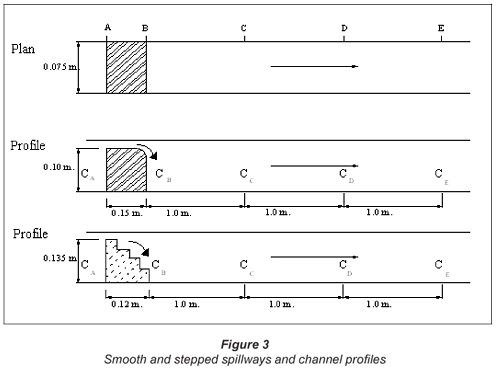
Result and discussion
The results are presented in Figs. 4 to 12.The comparison between E20-discharge on smooth and stepped spillways is presented in Figs. 4 to 7. In Figs. 8 and 9, the effect of discharge on DO% was investigated. The relationship between E20 and tail-water depth (hM) for the spillways is shown in Figs. 10 and 11. Finally, average DO% is compared for the spillways in Fig. 12.
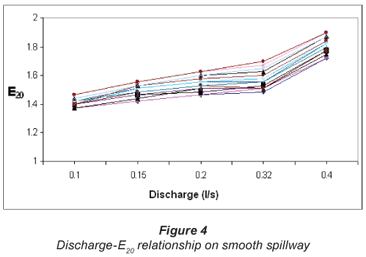
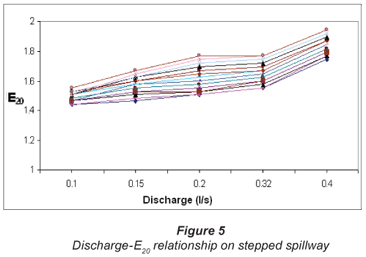
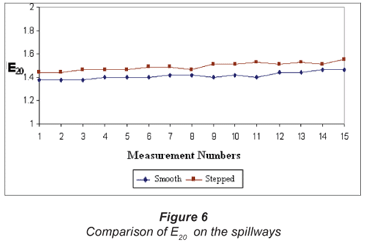
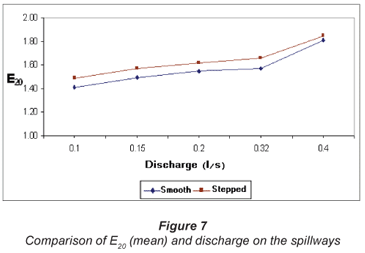
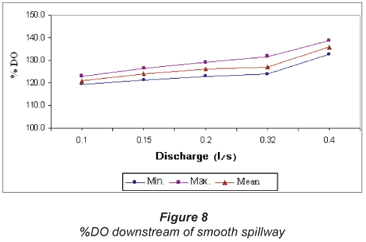
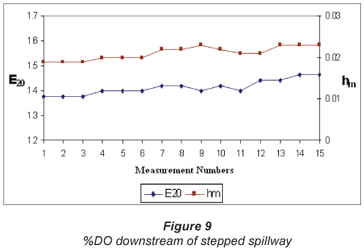
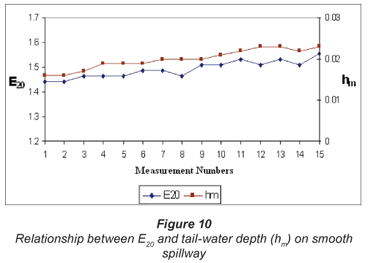
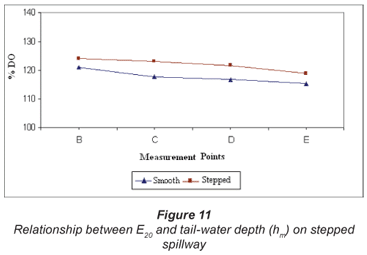
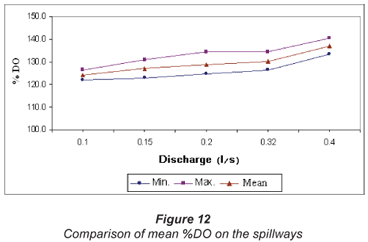
Figures 4 to 7 show that E20 increased with discharge on the 2 spillway types. The E20 value varies between 1.35 and 1.90 on smooth spillways and between 1.40 and 1.95 on stepped spillways. A higher aeration was observed on the stepped spillway, because surface aeration, plunging jet aeration and hydraulic jump aeration occurred on the stepped spillway. E20 values rose most sharply for discharges between 0.32 ℓ/s and 0.40 ℓ/s. In the same way, %DO increased with discharge. Supersaturation was seen on both spillway types, with DO above 100%.
Tail-water depth has little effect on the aeration efficiency on the spillways. E20 increased with tailwater depth. Tailwater depth varied between 0.02 m and 0.03 m. Therefore, the tailwater effect on aeration was seen to be more important for the smooth spillway.
Spillway type, discharge rates, tail-water depth and flow types affect the aeration efficiency along the channel length. In both nappe and skimming flow regimes, the air-water gas transfer taking place above a stepped chute is enhanced by the strong turbulent mixing and flow caused by aeration. Aeration caused by the flow must be taken into account for the re-oxygenation of polluted streams and rivers.
The flow patterns of a stepped spillway and smooth spillway have varying hydraulic characteristics. The hydraulic characteristics, flow-caused aeration and hydrodynamic interactions between the flow and the steps must be taken into account.
Two distinct flow regimes on stepped spillways are nappe and skimming flows. In nappe flow, the steps act as a series of over-falls with the water plunging from one step to another. Water flows as a coherent stream over the pseudo-bottom formed by the outer step edges. The flow is without air pockets under the jets in skimming flow.
In the experiments, nappe flow with low discharges (0.10, 0.15, 0.20 ℓ/s) and skimming flow with high discharges (0.32 and 0.40 ℓ/s) occurred. The results of our experimental study indicate that the aeration efficiency of nappe flows is primarily a function of the discharge and channel length. The oxygen transfer increases with increasing chute length. In skimming flow conditions, aeration efficiency is nearly zero as long as no free-surface aeration occurs. Tail-water depth has little effect on the aeration efficiency of skimming flows. Smooth spillway aeration caused lower aeration efficiencies, depending on travel time, discharge rate and tail-water depth, than the stepped spillway (Figs. 4 to12) (Aras, 2009).
Conclusions
In both nappe and skimming flow regimes, the air-water gas transfer taking place above a stepped chute is enhanced by the strong turbulent mixing and by the aeration of the flow. The flow aeration must be taken into account for the re-oxygenation of polluted streams and rivers, but also to explain the high fish mortality downstream of large hydraulic structures.
As the flow patterns of stepped channel flows are very different from smooth chute flow situations, designers must select the appropriate flow regime and carefully analyse the stepped channel flows. Designers must take into account the hydraulic characteristics, the flow aeration and the hydrodynamic interactions between the flow and the steps.
Dissolved oxygen concentrations and aeration efficiency along the spillway channel increase with increasing flow rates, for smooth and stepped spillways. Aeration efficiency of the stepped spillway is higher than the smooth-crested spillway along the channel, for the same flow rates. Tail-water depth has little effect on aeration efficiency on both smooth and stepped spillway. E20 increases with increasing tail-water depth.
Acknowledgements
Related research was supported by the Research Funds of Karadeniz Technical University – Project No. 20.112.001.5 and Project No. 21.112.001.1.
References
ARAS E (2009) Effects of Aeration through the Hydraulic Structures on Dissolved Oxygen Balance in Rivers and on the Optimization of Wastewater Treatment System (in Turkish). PhD Thesis, Karadeniz Technical University, Department of Civil Engineering, Trabzon, Turkey. [ Links ]
ARAS E and BERKUN M (2008) Spillway and metal toxicity influenced stream reaeration. J. Environ. Eng. ASCE 134 (9) 809-811. [ Links ]
BAYLAR A, EMIROGLU ME and BAGATUR T (2006) An experimental investigation of aeration performance in stepped spillways. Water Environ. J. 20 (1) 35-42. [ Links ]
BAYLAR A, BAGATUR T and EMIROGLU ME (2007) Aeration efficiency with nappe flow over stepped cascades. Proc. Inst. Civil Eng.-Water Manage. 160 (1) 43-50. [ Links ]
BERKUN M and ONAL A (2004) Effects of inorganic metals on respirometric oxygen uptake and related sag curve formations in streams. Water SA 30 (2) 273-278. [ Links ]
BRATTBERG T and CHANSON H (1998) Air entrapment and air bubble dispersion at two dimensional plunging water jet. Chem. Eng. Sci. 53 (24) 4113-4127. [ Links ]
CAROSI G and CHANSON H (2008) Turbulence characteristics in skimming flows on stepped spillways. Can. J. of Civil Eng. 35 (9) 865-880. [ Links ]
CHANSON H (1994) Hydraulic design of stepped cascade, channels, weirs and spillways. Elsevier Science Ltd., Oxford, England. [ Links ]
CHANSON H (1995) Air-water gas transfer at hydraulic jump with partially developed inflow. Water Resour. Res. 29 (10) 2247-2254. [ Links ]
CHANSON H (1997) Air bubble entrainment in open channels: flow structure and bubble size distributions. Int. J. Multıphase Flow 23 (1) 193-203. [ Links ]
CHEN GH, LEONG MI, LIU J, HUANG JC, LO IMC and YEN BC (2000). Oxygen deficit determinations for major river in eastern Hong Kong, China. Chemosphere 41 7-13. [ Links ]
EMIROGLU ME and BAYLAR A (2005) Influence of included angle and sill slope on air entrainment of triangular planform labyrinth weirs. J. Hydraul. Eng. 131 (3) 184-189. [ Links ]
FRIZELL KH (1992) Hydraulics of stepped spillways for RCC dams and dam rehabilitation. Proc.3rd Specialty Conf. on Roller Compacted Concrete, ASCE, San Diego, USA. p. 423-439 [ Links ]
GONZALEZ CA (2005) An Experimental Study of Free-Surface Aeration on Embankment Stepped Chutes. PhD Thesis, Department of Civil Engineering, The University of Queensland. [ Links ]
KOKPINAR MA (1996) Air Entrainment in High Speed Free Surface Flows. PhD Thesis, Middle East Technical University, Turkey. [ Links ]
ORLINS JJ and GULLIVER JS (1997) Prediction of dissolved gas concentrations downstream of a spillway. Proc. XXVII. IAHR Congr., New York. p. 524-529. [ Links ]
PETERKA AJ (1953) The effect of entrained air on cavitation pitting. Joint Meeting Paper, IAHR/ASCE, Minneapolis, Minnesota. 507-518. [ Links ]
PEYRAS L, ROYET P and DEGOUTTE G (1992) Flow and energy dissipation over stepped gabion weirs. J. Hydraul. Eng. 118 (5) 707-717. [ Links ]
PFISTER M, HAGER WH and MINOR HE (2006) Bottom aeration of stepped spillways. J. Hydraul. Eng. 132 (8) 850-853. [ Links ]
RUSSELL SO and SHEEHAN GJ (1974) Effect of entrained air on cavitation damage. Can. J. Civil Eng. 1 97-107. [ Links ]
SENE KJ (1988) Air entrainment by plunging jets. Chem. Eng. Sci. 43 2615-2623. [ Links ]
TOOMBES L and CHANSON H (2000) Air-water flow and gas transfer at aeration cascades: A comparative study of smooth and stepped chutes. Proc. International Workshop on Hydraulics of Stepped Spillways, Balkema, Rotterdam, The Netherlands. 77-84. [ Links ]
Received 5 June 2009; accepted in revised form 11 March 2010.
* To whom all correspondence should be addressed.
+90 462 377 3547; fax: +90 462 377 2606;
e-mail: egemen@ktu.edu.tr













